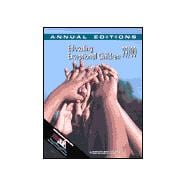| To the Reader | iv | ||||
| Look Guide | 2 | (2) | |||
| Selected World Wide Web Sites | 4 | (2) | |||
| UNIT 1 Inclusive Education Four articles present strategies for establishing positive interactions between students with and without special needs. | |||||
| Overview | 6 | (20) | |||
|
8 | (4) | |||
|
|||||
|
|||||
|
12 | (6) | |||
|
|||||
|
|||||
|
18 | (3) | |||
|
|||||
|
|||||
|
21 | (5) | |||
|
|||||
|
|||||
|
|||||
| UNIT 2 Early Childhood Four unit articles discuss the implementation of special services to preschoolers with disabilities. | |||||
| Overview | 26 | (20) | |||
|
28 | (5) | |||
|
|||||
|
|||||
|
|||||
|
|||||
|
33 | (3) | |||
|
|||||
|
|||||
|
36 | (5) | |||
|
|||||
|
|||||
|
|||||
|
|||||
|
|||||
|
41 | (5) | |||
|
|||||
|
|||||
|
|||||
|
|||||
| UNIT 3 Learning Disabilities The assessment and special needs of students with learning disabilities are addressed in his unit's three selections. | |||||
| Overview | 46 | (30) | |||
|
48 | (20) | |||
|
|||||
|
|||||
|
68 | (4) | |||
|
|||||
|
|||||
|
|||||
|
|||||
|
72 | (4) | |||
|
|||||
|
|||||
|
|||||
|
|||||
|
|||||
| UNIT 4 Speech and Language Impairments In this unit, two selections examine communication disorders and suggest ways in which students can develop their speech and language. | |||||
| Overview | 76 | (14) | |||
|
78 | (4) | |||
|
|||||
|
|||||
|
82 | (8) | |||
|
|||||
|
|||||
| UNIT 5 Mental Retardation, Autism, and Traumatic Brain Injuries Four articles in this section discuss concerns and strategies for providing optimal educational programs for students with mental retardation, autism, and traumatic brain injuries. | |||||
| Overview | 90 | (22) | |||
|
92 | (7) | |||
|
|||||
|
|||||
|
|||||
|
|||||
|
|||||
|
99 | (6) | |||
|
|||||
|
|||||
|
|||||
|
|||||
|
|||||
|
105 | (4) | |||
|
|||||
|
|||||
|
|||||
|
109 | (3) | |||
|
|||||
|
|||||
| UNIT 6 Emotional and Behavioral Disturbances Ways to teach emotionally and behaviorally disordered students are discussed in the unit's three articles. | |||||
| Overview | 112 | (18) | |||
|
114 | (6) | |||
|
|||||
|
|||||
|
|||||
|
120 | (6) | |||
|
|||||
|
|||||
|
|||||
|
126 | (4) | |||
|
|||||
|
|||||
|
|||||
|
|||||
| UNIT 7 Vision and Hearing Impairments Three selections discuss the special needs of visually and hearing impaired children from infancy through secondary school. | |||||
| Overview | 130 | (18) | |||
|
132 | (5) | |||
|
|||||
|
|||||
|
137 | (6) | |||
|
|||||
|
|||||
|
|||||
|
143 | (5) | |||
|
|||||
|
|||||
|
|||||
| UNIT 8 Multiple Disabilities The educational implications of medical treatments for children with multiple impairments are examined in this unit's three articles. | |||||
| Overview | 148 | (18) | |||
|
150 | (4) | |||
|
|||||
|
|||||
|
|||||
|
154 | (6) | |||
|
|||||
|
|||||
|
|||||
|
160 | (6) | |||
|
|||||
|
|||||
| UNIT 9 Orthopedic and Health Impairments In this unit, three articles discuss how health problems and mobility impairments have an impact on a child's education. | |||||
| Overview | 166 | (16) | |||
|
168 | (5) | |||
|
|||||
|
|||||
|
173 | (3) | |||
|
|||||
|
|||||
|
176 | (6) | |||
|
|||||
|
|||||
| UNIT 10 Giftedness Three articles examine the need for special services for gifted and talented students, assessment of giftedness, and ways to teach these students. | |||||
| Overview | 182 | (12) | |||
|
184 | (3) | |||
|
|||||
|
|||||
|
187 | (4) | |||
|
|||||
|
|||||
|
191 | (3) | |||
|
|||||
|
|||||
|
|||||
| UNIT 11 Transition The three articles in this section examine the problems and issues regarding transitions within school or from school to the community and workforce. | |||||
| Overview | 194 | (31) | |||
|
196 | (8) | |||
|
|||||
|
|||||
|
204 | (16) | |||
|
|||||
|
|||||
|
|||||
|
220 | (5) | |||
|
|||||
|
|||||
|
|||||
|
|||||
| Index | 225 | (3) | |||
| Article Review Form | 228 | (1) | |||
| Article Rating Form | 229 |








